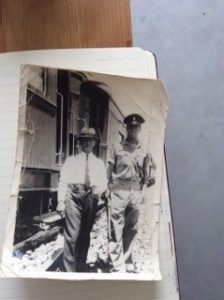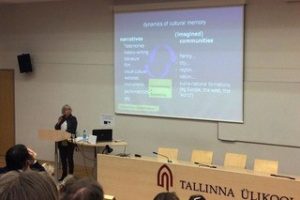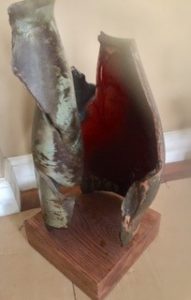Dr Claire Launchbury reports from a recent conference in Estonia exploring transcultural memory studies.
I recently attended a conference in Tallin University, Transcultural Memorial Forms: Contemporary Remembrance of War, Displacement and Political Rupture, which additionally marked the inauguration of a new research network on Memory Studies, bringing together colleagues predominantly from the Nordic and Baltic regions where the discipline is thriving. This network showcases the different borderlines and geographical areas of collaboration that are available to this part of Northern Europe. Even down to the food, Estonia’s position on the Scandinavian-Baltic frontier and neighbouring Russia leads to different combinations: Nordic cured fish, Russian dumplings, Armenian coleslaw with olives and pomegranates all appear on the same menu. The exotic sea resort is Odessa. Traces of former Soviet architecture co-exist with a number of large shopping malls with all the usual brands. A picture-postcard old town with museums of medieval torture, ecclesiastical history also throbs with the merry antics of the Helsinki Finns taking a booze cruise or the budget airline stag partiers. These passing observations reinforced several of the issues raised at the conference with its focus on transcultural forms.
A fascinating and packed programme included keynotes by Michael Rothberg, Samuel Goetz Chair of Jewish Studies, UCLA and Ann Rigney, University of Utrecht, and a screening of Common Ground and a talk with filmmaker, Kristina Norman. Papers explored a diverse range of cultural and memorial production, from northern comedy to Althusser (and that was in just one paper) as well as providing a welcome opportunity to discuss the issues at stake in contemporary memory studies.
My panel on memorial forms showcased memorial projects such as the Museum on Wheels commemorating the lost Jews of Poland and their reception in different parts of the county in a paper by Aleksandra Kubica (KCL). Neringa Latvyte-Gustaitiene (Vilnius) examined the palimpsestic nature of Lithuanian memorials to the Jewish victim of the ‘Shoah par balles’ or the ‘Holocaust by bullets’ between 1941 and 1944. There are 250 sites of mass killing in Lithuania and the passage from Soviet power to contemporary Europe has left many conflicting, competing and problematic traces which have an urgency to them that Western Europe might have a tendency to neglect. Indeed, this highly unsteady transition of memory was a subject returned to often at the conference.

Ernest Morgan, Palestine Railways, & a Police Constable in the aftermath of a train derailment in 1937
My own paper ‘How am I supposed to talk to you, or with you or about you?’ explored the novel Gate of the Sun by Lebanese writer, Elias Khoury, through the lens of disruptive empathy, a term coined by Amos Goldberg and Bachir Bachir to think through co-remembering the Shoah and the Nakba of 1948. In addition to this I explored the potential of the text as a productive borderspace using Bracha Ettinger’s radical concept she terms the Matrixial. She uses this to argue for the possibility of co-wit(h)nessing, instead of being separated from the other, cut, split, castrated, the uterine model of the matrixial holds open the opportunity for connection and compassion. In this way, I explored different instances of seemingly impossible coexistences at events which are narrated in the novel. I reflected on the Arab revolt of 1936-39 which intersects with the experience of my great-grandfather being on board sabotaged trains as he worked for Palestine Railways, the problems of borders and their crossing at Allenby or Qaalandia, the checkpoint between Ramallah and East Jerusalem, my own experience in 2015; the time in late 1975 when the PLO protected and fed the Jewish population of Wadi Abu Jamil in Beirut, however cynical the geopolitics, and, finally, a sculpture by Ginane Makki Bacho made from Israeli shells that destroyed her apartment and studio in 1982. A sculpture she named ‘uterus’.
In these volatile political times, considering different networks, of memory, solidarity, compassion; the other memoryscapes which we might share but nevertheless not pay sufficient attention to, offers, I like to hope, a sense of renewed dialogue and through that understanding. I am very grateful to conference organisers, Eneken Laanes and Hanna Meretoja for their intellectual leadership, organisation and warm welcome and to the School of Advanced Study, University of London, conference grant fund for supporting my participation.
References
Elias Khoury [1998], Gate of the Sun [Bab el Shams] translated by H. Davies (London: Picador, 2007);
Bashir Bashir and Amos Goldberg (2014) ‘Deliberating the Holocaust and the Nakba: Disruptive Empathy and Binationalism in Israel/Palestine’ Journal of Genocide Research, 16.1, 77-99;
Bracha Ettinger (2006), The Matrixial Borderspace, with foreword by Judith Butler, introduction by Griselda Pollock and afterword by Brian Massumi (Minneapolis: University of Minneapolis Press).
Dr Claire Launchbury, Centre for Cultural Memory, Institute of Modern Languages Research



